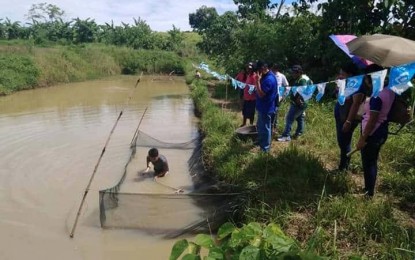
AQUACULTURE TECH. Tilapia producers in Quirino province learn the semi-intensive culture that could boost their production, according to the Bureau of Fisheries and Aquatic Resources 2 (Cagayan Valley). Senior aquaculturist Jennifer Tattao said on Tuesday (Nov. 26, 2019) that fish farmers may now be able to grow tilapia at lower costs by using naturally available food. (Photo courtesy of BFAR-2)
TUGUEGARAO CITY, Cagayan -- Fisherfolk may now be able to grow tilapia at lower costs by using naturally available food as supplementary feed to provide extra nutrients to the fish in addition to commercial feeds.
Senior aquaculturist Jennifer Tattao of the Bureau of Fisheries and Aquatic Resources (BFAR) 2 (Cagayan Valley) said data from the Philippine Statistics Authority in 2018 show that Quirino produced 3.46 percent of the region’s total tilapia production but she believes that the province has the capacity to produce more should it use its untapped potential for aquaculture.
"The bureau is promoting the production of natural food through proper pond fertilization and (the) use of locally available materials, such as duckweeds,” Tattao said in a press briefing here Monday.
Through the proper use of water resources and the right technology, the landlocked and mountainous province of Quirino has the potential to significantly augment its fish supply, she added.
Fishpond development and integrating aquaculture in rice farming have potentials, Tattao said, adding that the bureau is ready to render technical assistance to fisherfolk to implement these.
“The high return on investment recorded in several Semi-Intensive Culture of Tilapia in Pond techno-demo projects of the bureau in Quirino and the continuous efforts to educate residents on fish farming are steps toward the same direction,” she said.
Tattao cited the demo project in the farm of Christopher Pardito in Aglipay, Quirino who was able to get a 47.57-percent return on investment, or an income of PHP14,732, from his production cost of PHP30,698.
Pardito stocked a total of 2,250 tilapia fingerlings in his 450-square-meter pond and harvested 457 kg. by the end of the culture period.
Other successful techno-demo recipients this year who used the same technology are Maribel Sumibcay and Rodel Baclig of Villa Pascua, Maddela, Quirino. They achieved a 33.46-percent and 31.73-percent return on investment, respectively.
Dr. Milagros Morales, BFAR-2 director, lauded the accomplishments of the Production Division in bringing fishing technologies closer to the fisherfolk.
“We want to help our fisherfolk-client to adapt with the best and latest developments in the field of technology. We can make their life a lot easier while becoming more productive, thereby attaining abundant fish supply in the market and high income for the fisherfolk,” Morales said. (PNA)
